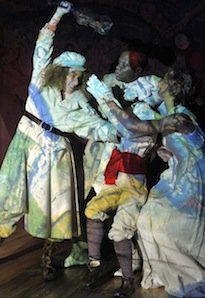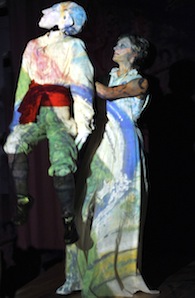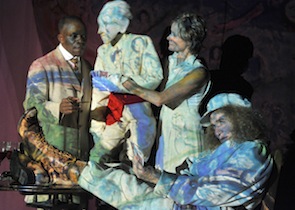
When Igor Stravinsky composed The Soldier’s Tale, his instructions were explicit: The 1918 work was meant “to be read, played, and danced.” This month at the Aurora Theatre, a stellar group of artists is coming together to do just that. The new production, co-directed by Tom Ross and Muriel Maffre, promises one of the season’s most remarkable collaborations.
Ross, Aurora’s artistic director, and Maffre, former prima ballerina with the San Francisco Ballet, have assembled a rare multi-disciplinary team to meld music, drama, movement, puppetry, and art. With musical arrangements by Berkeley West Edge Opera’s Jonathan Khuner and an English translation of C.F. Ramuz’s libretto by Pocket Opera’s Donald Pippin, four members of the San Francisco chamber group Earplay under Music Director Mary Chun will perform Stravinsky’s score. The cast features L. Peter Callender in the dual role of the Narrator/Soldier, Joan Mankin as the Devil and Maffre as the King’s Daughter. The designer is Benjamin Pierce.
Ross, who co-founded the Aurora with Barbara Oliver in 1992, says the new production is unlike anything the award-winning company has done to date. “It’s something very different for us,” said Ross, who has staged 22 productions for Aurora, including the recent season opener, Edward Albee’s A Delicate Balance. (He’s still reeling from opening night, when Albee, in town to catch the production, joined the audience in a standing ovation.)
Ross credits Maffre for bringing The Soldier’s Tale to his attention. The acclaimed dancer, who retired from San Francisco Ballet in 2007, approached him about the work after directing it in 2006 for the Orcas Island Chamber Music festival.
“I knew Stavinsky’s music, but I really didn’t know this piece,” Ross explains. “But Muriel was passionate about it. I was intrigued by the idea of this fusion of music, dancing and acting. And the idea of doing the piece in the intimate space of the Aurora just sounded wonderful to me.”
Ross allows that the intimate space posed considerable challenges. The Soldier’s Tale is often performed in concert halls, and when the company workshopped the piece in December of 2010, it quickly became apparent that creative solutions were needed to get all of the elements onstage.

Ross and Maffre turned to Khuner, who suggested using Stravinsky’s own suite, a reduction that calls for three musicians — violin, clarinet, and piano — instead of the original score’s seven. “Jonathan also added a percussionist, to really knock it out of the park,” says Ross. “With the four musicians, I think it works very well.”
Ross has made a specialty of intimate stagings at the Aurora; now celebrating its 20th anniversary season, the company has risen from its beginnings in a tiny space at the Berkeley City Club to its current home on Addison Street. Along the way, it’s gained a reputation as one of the Bay Area’s most innovative theater companies — one that offers a great mix of classic plays, new works and little-known treasures.
The Soldier’s Tale, for most theatergoers, probably fits into the latter category. It’s eminently theatrical, but rarely staged by theater companies. Ross says he’s not quite sure why; he thinks it’s a perfect fit for the Aurora. Based on a Russian folk story, the narrative follows a soldier who makes a deal with the devil, trading his fiddle for a book that predicts the future.
“It was written as an anti-war piece, of course, and it seems we’re always at war,” says Ross. “But what also appealed to me was the timelessness of this fairy tale story, the Faustian nature of a man basically giving up his soul, represented by the fiddle, to the devil in exchange for a book that predicts the future. He knows what the stock market is before it all happens. That element, and the greed portrayed, is all so timeless.”
Just as essential for Maffre are the music and movement aspects of the piece. When we met after a recent rehearsal, Ross’s co-director noted that the use of puppetry — specifically, the lifesize puppet named Joseph created for the show — made her want to re-visit The Soldier’s Tale. (As we talked, Joseph was slumped over on a nearby platform, clad in khaki and looking rather exhausted.)

“On Orcas Island, I worked closely with the puppet artist David Densmore to develop the kinesthetic movement I wanted the puppet to have,” said Maffre. “From that, he created this little being. I fell in love with Joseph, and the idea of bringing the piece here is because of him.”
The puppetry is bunraku style, and as puppeteer, Maffre has developed a specific movement language for herself and for Joseph. Now, she’s working with the rest of the cast to create a unified approach. “I’m working with them on being aware of the weight of their limbs and how the limbs are moving from the body instead of from the mind,” she says. “This is what’s happening with the puppet. It’s organic in a very primal way.
“The puppet has been a great teacher to me,” adds Maffre. “He’s informing a lot of the movement in the choreography.”
The Soldier’s Tale was composed at a critical time in Stravinsky’s career; cut off from his primary income sources during the Great War, he and Ramuz were exiled in Switzerland, and they imagined the cautionary tale as a traveling piece, meant to be performed in small theaters throughout Switzerland. The score is a wide-ranging, rhythmically complex, often sardonically funny mix of marches, chorales, jazz, ragtime, and tango episodes. Maffre, who has danced many of the composer’s ballets, finds it endlessly fascinating. “It’s very evocative, very colorful,” she says. “I’m always touched by references to folklore in music, and there’s a lot of that in this piece.”
As they work on the new staging, Maffre and Ross have experienced several serendipitous moments; early in the process, they discovered they share a mutual love of Chagall. The Russian-French painter’s use of color and fantasy is informing Pierce’s designs, creating a vibrant look for the staging.
Maffre’s staging for Orcas Island was a hit — The Seattle Times called it “both visually and musically mesmerizing” — and she and Ross hope audiences will embrace Aurora’s production in Berkeley. “It’s a challenging piece,” says Maffre. “But the idea here is really to bring the three art forms and develop them at the same level, so that the music is as important as the text or the movement or the acting. That doesn’t happen very often — all of these art forms function differently, and it’s not easy to find the right people at the right time. But I think the combination is really going to be something special.”
